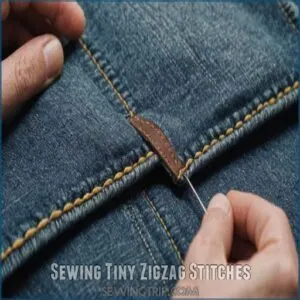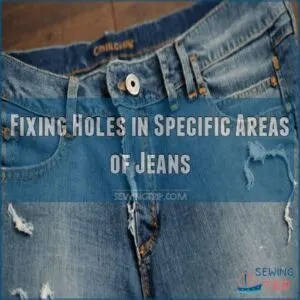This site is supported by our readers. We may earn a commission, at no cost to you, if you purchase through links.

For small tears, grab a needle and thread that matches your denim’s color, then use a simple straight stitch to close the gap.
Larger holes? Try patching from the inside with matching denim and reinforcing with a zigzag stitch.
If you’re not confident with needle and thread, iron-on patches work like magic – just make sure to follow the temperature settings.
There’s even a way to turn that annoying tear into a fashion statement using decorative patches or artistic embroidery.
Table Of Contents
- Key Takeaways
- Patching Techniques for Jeans Repair
- How to Repair a Hole in Jeans
- Choosing The Right Materials and Tools
- Hand Sewing a Hole in Jeans
- Sewing a Hole in Jeans With a Patch
- Decorative and Embroidery Techniques
- Fixing Holes in Specific Areas of Jeans
- No-Sew Methods for Fixing Holes in Jeans
- Tips and Considerations for Jeans Repair
- Common Mistakes to Avoid in Jeans Repair
- Frequently Asked Questions (FAQs)
- Conclusion
Key Takeaways
- You’ll need to match your repair method to the hole size – use simple straight stitches for small tears and denim patches with zigzag stitches for larger holes.
- You can transform holes into decorative features using embroidery stitches or Sashiko patterns, turning damaged jeans into unique fashion statements.
- If you’re not confident with sewing, iron-on patches offer a quick fix, but they’ll last longer if you reinforce them with a few stitches around the edges.
- You’ll get the best results by trimming frayed edges, using matching thread color, and reinforcing high-stress areas like knees and inner thighs with extra stitching.
Patching Techniques for Jeans Repair
When your favorite jeans develop an unfortunate rip or tear, patching techniques come to the rescue with simple solutions.
You can patch from underneath or use iron-on patches for a quick fix; just watch out, your old jeans might start looking better than your new ones!
Patching From Underneath
Patching jeans from underneath is your ticket to discreet fix-ups that blend style with practicality.
Start by choosing the right denim color match for your patch.
Then, secure it with basting stitches or fusible webbing.
Finally, stitch it up with zigzag or straight lines for added durability.
A solid patch won’t bail after washday adventures!
- Denim Match: Find a compatible fabric.
- Securing Methods: Use basting or webbing.
- Stitch Types: Opt for zigzag or straight stitches.
Hand Sewing Straight Tears
Ever face a straight tear in your favorite jeans?
No worries, hand sewing can save the day!
Grab some fabric mending tape or interfacing for extra strength.
Heat-seal it underneath, then overcast stitch along the tear.
Choose a matching thread to blend seamlessly.
It’s like you’re weaving magic back into your denim, ensuring it’s strong and stylish.
Iron-on Patches for Quick Fix
Switching from sewing to speed, grab an iron-on patch for your jeans.
It’s like a speedy band-aid, sticking precisely where you need it for nearly invisible fixes.
Here’s how:
- Patch Placement: Aim for at least 1/4 inch overlap.
- Heat Matters: Iron evenly.
- Patch Design: Get creative with shapes.
- Durability Tip: Secure with stitches!
How to Repair a Hole in Jeans
Got a hole in your favorite jeans? No worries, it happens to the best of us. Jumping from our patching tips, let’s chat about how you can breathe new life into those beloved denim pieces.
1) Start with a clean slate: trim any frayed edges around the hole to prevent further unraveling.
2) Before you begin stitching, make sure to thread your needle correctly by matching the needle size to your fabric thickness for a seamless repair.
2) Go for a stealth move by using darning stitches, weaving threads over the hole like a pro. This technique is subtle and sturdy, perfect for a quick fix.
3) Feeling artsy? Grab some embroidery thread and transform that rip into a creative focal point with fun patterns. Your jeans will look great, but they’ll also tell a unique story. So, get stitching and embrace sustainable fashion!
Choosing The Right Materials and Tools
Before you start patching, gather your supplies!
You’ll need sturdy thread, a needle strong enough for denim (a heavy-duty one’s best!), and maybe some scissors, a ruler, and a patch if you’re going the extra mile – remember that time you accidentally used embroidery floss?
Let’s avoid that this time!
Fabric Scissors and Ruler
To mend those jeans like a pro, arm yourself with fabric scissors and a trusty ruler.
Snipping shabby edges is a breeze with sharp scissors, while a ruler keeps your cuts precise.
Think of them as your trusty sidekicks for a repair mission.
Precision tools like these give you the confidence to say, "I’ve got this!
All-Purpose Polyester Thread
Thread choice in jeans repair can make or break your project. All-purpose polyester thread is your go-to hero—strong, flexible, and perfect for patching holes.
- Thread types: Choose polyester for durability.
- Thread strength: Withstands wear and tear.
- Thread color: Match closely to your jeans.
- Thread tension: Keep it even for smooth stitching.
Choosing the right thread sets you up for success!
Heavy-Duty Needle and Serger
Imagine tackling denim with a heavy-duty needle—it’s like having the right sword for a fierce battle.
Needle sizes matter, and a serger adds the finishing touch for sturdy seams.
Be mindful of fabric weight and thread types.
Here’s a quick guide:
| Needle Sizes | Serger Uses | Thread Types |
|---|---|---|
| 90/14 | Seams | Polyester |
| 100/16 | Finishing | Denim |
| 110/18 | Stretch | All-purpose |
| 120/20 | Repairing | Embroidery |
| 130/22 | Hemming | Heavyweight |
Bonding Web and Iron-on Fabric Glue
When your jeans need patching, bonding web and iron-on fabric glue are your best friends.
These handy options keep patches in place like magic.
- Bonding Web vs. Glue: Web offers flexibility—cut to any shape and size.
- Pros and Cons: Web is neat, glue is fast.
- Alternatives: Double-sided tape or fusible interfacing for a quick fix.
Hand Sewing a Hole in Jeans
Grabbing a needle and thread to fix a hole in your jeans might seem old-fashioned, but it’s like a secret handshake into the realm of DIY.
You’ll trim those pesky frayed edges, weave some stitches, and soon enough, you’ll have jeans that are repaired but also proudly showing off your handiwork.
Trimming Excess Thread and Frayed Edges
Before you tackle those stitches, grab those scissors—it’s snip time!
Trim away loose threads and frayed edges, channeling your inner barber.
This might seem straightforward, but clean edges mean a seamless repair.
Think of it as giving your jeans a fresh haircut, prepping them for a new style.
A tidy start sets you up for sewing success.
Threading The Needle and Weaving Stitches
Now that those edges are neat, grab your needle.
To start, make sure you’re using the proper hand sewing basics, including creating a knot at the end of the thread, as discussed in hand stitching techniques.
Choose a heavy-duty needle—a 90/14 or 100/16 depending on your denim’s weight.
Thread it with strong polyester thread matching your jeans.
Here’s what to do next:
- Insert the needle from the inside.
- Keep your thread tension consistent.
- Use small, even stitches.
- Aim for straight stitches across the hole.
- Work slowly and methodically for a strong repair.
Tying Off The Thread Inside The Jeans
To make these repairs even more durable, learn how to fix zipper teeth quickly repairing a zipper’s teeth. Three quick steps guarantee your repair stays put.
Start by flipping your jeans inside out and making a small knot close to your last stitch.
For extra security, weave your needle back through the previous stitches, creating a loop pattern.
Finally, tie off with a double knot and trim any excess thread – leaving about 1/4 inch to prevent unraveling.
If you’re new to hand sewing, consider investing in a hand sewing starter kit to ensure you have the necessary tools for the job.
Sewing a Hole in Jeans With a Patch
You’ll save those favorite jeans from the donation pile when you master the art of patching holes with matching denim and some simple stitching.
Before you start transforming your jeans from holey to wholly restored, gather your supplies: a patch of denim slightly lighter than your jeans, bonding web or fabric glue, and your trusty needle and thread.
Measuring and Cutting The Patch
Every successful jean repair starts with precise patch measurements.
Here’s how to nail the perfect patch every time:
- Measure the hole’s dimensions and add a 1/2 inch border on all sides.
For tougher repairs, consider using canvas fabric, such as Dewdrop Navy Cotton Canvas Fabric, which is ideal for durable patches.
- Choose denim fabric slightly lighter than your jeans for an invisible fix
- Cut your patch into a rounded rectangle to prevent corner lifting
- Match the fabric grain to your jeans for the strongest hold
Applying Bonding Web or Iron-on Fabric Glue
Once you’ve cut your patch to size, it’s time for the sticky business.
Apply bonding web or fabric glue along the patch edges, creating a thin, even layer.
For bonding web, press with a warm iron for 10-15 seconds.
Using fabric glue? Let it dry for an hour before handling.
Both options work great, but bonding web tends to hold up better in the wash.
Sewing Tiny Zigzag Stitches
Now that your patch is securely bonded, it’s time for the fun part.
To create nearly invisible stitches, consider using a blind hem foot, which features a metal guide for accurate stitching and three grooves to prevent fabric slippage, as seen in sewing with a blind hem foot. Set your sewing machine to a tight zigzag stitch – think tiny steps of a careful dancer.
You can achieve professional-looking results with a high-quality zigzag sewing machine.
You’ll want to sew around the patch’s edges about 1/8 inch from the edge, keeping your stitches close together.
This creates a durable, almost invisible repair that’ll hold up through countless washes and adventures.
Decorative and Embroidery Techniques
You’ll love turning those pesky holes in your jeans into eye-catching conversation pieces with decorative repairs and embroidery techniques that add personality to your denim.
Whether you’re stitching colorful patterns or applying unique fabric patches, you can transform worn spots into artistic statements that’ll have friends asking where you bought your custom jeans.
Embroidery Stitches for Filling Holes
Transform unsightly holes into eye-catching designs with embroidery stitches.
You’ll need embroidery thread that matches or complements your jeans’ color and a sturdy needle.
Start by marking the hole’s perimeter with chalk, then weave vertical stitches across the opening.
Layer horizontal stitches over them to create a tight, basket-weave pattern.
For extra flair, try geometric shapes or simple floral designs around the repair.
Sashiko Stitches for Traditional Japanese Embroidery
The ancient art of Sashiko stitching brings a touch of Japanese elegance to your denim repairs.
This unique embroidery technique, characterized by simple running stitches on indigo fabric, utilizes geometric patterns and motifs, creating a minimalist aesthetic.
Using crisp white thread and simple running stitches, you’ll create geometric patterns that transform tears into eye-catching designs.
Start with basic straight lines, then experiment with traditional patterns like waves or diamonds.
It’s like meditation with a needle – therapeutic and beautiful at the same time.
Decorative Fabric Patches for Unique Repairs
Using a fabric adhesive like Speed Sew for repairs, you can quickly and easily fix a torn seam, and then creative fabric patches turn repair projects into fashion statements, letting your personality shine through torn denim. Whether you’re looking for a durable fix or a creative expression, choosing the right patch material compatible with denim is crucial for a long-lasting repair. Whether you’re adding lace for a romantic touch or bold prints for a funky vibe, decorative patches make your jeans uniquely yours.
- Layer contrasting denim pieces for an edgy patchwork look
- Add vintage embroidered patches from thrift stores
- Mix in delicate lace panels for feminine flair
- Use colorful printed fabrics for a bohemian style
- Incorporate iron-on appliques for quick artistic fixes
Fixing Holes in Specific Areas of Jeans
You’ll need different repair techniques for holes in high-stress areas like your jeans’ crotch, knees, and inner thighs since they’re prone to unique wear patterns.
Whether you’re fixing those pesky knee holes from gardening or patching up inner thigh wear from your daily bike commute, a simple knee hole repair guide can help you mend your jeans, we’ll show you the right method for each specific spot.
Repairing Crotch Holes
Chafing and friction make crotch holes a common enemy of your favorite jeans.
To prevent them from getting worse, start by reinforcing the area with a denim patch slightly lighter than your jeans.
Apply the patch from the inside using a zigzag stitch in a matching thread color.
For extra durability, add a second row of stitches and consider using iron-on interfacing as additional support.
Fixing Knee Holes
Knee holes in jeans tell tales of adventure, but they don’t have to be permanent battle scars.
Whether you’re a gardener or just prone to taking tumbles, here’s how to tackle those pesky knee tears:
- Cut a patch that extends 1 inch beyond the hole’s edges for maximum durability
- Pre-wash your patch to prevent shrinkage mishaps later
- Double-stitch in a diamond pattern for flexibility when kneeling
Mending Inner Thigh Holes
While knee repairs focus on visible patches, inner thigh holes need extra reinforcement due to constant friction.
You’ll want to pick a sturdy patch fabric that matches your jeans’ stretch level.
Start by trimming any frayed edges, then add a patch that extends at least an inch beyond the hole’s edges.
Double-stitch in a diamond pattern for maximum durability – your thighs will thank you later.
No-Sew Methods for Fixing Holes in Jeans
You don’t need to be a whiz with a needle and thread to rescue your favorite jeans from unsightly holes.
Iron-on patches and adhesive solutions offer quick fixes that’ll have your denim looking good as new in minutes.
Whether you’re dealing with a torn knee or a frayed pocket, these solutions can help.
Iron-on Denim Patches for Easy Repair
For quick and effective repairs, it’s essential to assess the tear learn how to sew a tear, and then iron-on denim patches offer a quick solution when you need to mend jeans without sewing.
To make sure a strong adhesive bond, make sure to follow proper ironing techniques, such as using a pressing cloth and adjusting your iron temperature according to fabric compatibility learn more about ironing on patches.
Simply cut the patch to size (allowing 1/4 inch overlap), position it over the hole, and press with a hot iron for about 30 seconds.
While these patches aren’t as durable as sewn repairs, you can extend their life by applying one patch inside and another outside the hole.
Iron-on Embroidered Patches for Decorative Touch
Decorative embroidered patches let you transform damaged jeans into personalized statement pieces.
Once you’ve picked a design that matches your style, center it over the hole with a 1/4-inch overlap on all sides.
Press firmly with a hot iron for about 30 seconds, making sure to cover every edge.
For extra durability, consider adding a few quick stitches around the border.
Tips and Considerations for Jeans Repair
You’ll save money and help the environment by fixing those pesky holes in your favorite jeans, but not every pair is worth the effort.
Before you grab your needle and thread, let’s check out some practical tips that’ll help you decide if your cherished denim deserves a second chance.
Worth It to Patch Jeans
Ever wondered if it’s worth patching those favorite jeans?
When you’ve got a quality pair that fits just right, patching can extend their life and save you money.
It’s an eco-friendly choice that keeps denim out of landfills.
Plus, with creative patching styles, you can turn wear and tear into personal style statements.
Just skip fixing cheap stretch jeans or kids’ outgrown pairs – they’re not worth the effort.
Choosing The Right Repair Method
Picking the right repair method for your jeans depends on several key factors.
For small holes, a simple hand-sewing technique with matching thread works great.
Larger tears benefit from patch reinforcement, while decorative patches can turn fashion mishaps into style statements.
Consider your fabric type too – lightweight denim needs gentler handling than heavyweight pairs.
If you’re short on time, iron-on patches offer a quick solution.
Preventing Future Holes and Tears
Through proper care and attention, you can greatly extend your jeans’ lifespan.
Invest in jeans with a proper fit – too tight means more stress on seams.
Consider using a jeans repair kit to fix small issues before they become big problems.
Wash inside out in cold water and air dry to prevent unnecessary wear.
Reinforce high-stress areas like the inner thighs and knees before holes appear.
Common Mistakes to Avoid in Jeans Repair
You’ve mastered the basics of jean repair, but there are a few sneaky mistakes that can turn your mending project into a fashion fail faster than you can say "wrong thread color."
Common pitfalls that even seasoned sewers sometimes stumble into.
If you’re ready to take your DIY denim fixes from amateur to amazing, let’s look at the common pitfalls that even seasoned sewers sometimes stumble into.
Incorrect Thread Color and Type
Using the wrong thread can turn your repair job into a fashion faux pas.
Like dating, matching matters – your thread should coordinate with your denim’s color and weight.
Here’s what happens when you get it wrong:
- Light thread on dark jeans screams "home repair gone wrong"
- Weak thread snaps under daily movement
- Thick thread creates bulky, uncomfortable spots
- Synthetic thread melts during ironing
Choose all-purpose polyester thread that matches your jeans’ lighter thread color for best results.
Insufficient Stitches and Reinforcement
Don’t let weak stitches undermine your denim repair efforts.
After matching your thread color, you’ll need enough stitches to keep your patch secure.
Space them about 1/8 inch apart and double back for strength.
Think of it like building a tiny bridge – each stitch adds support.
Remember to check your thread tension too, as loose stitches can quickly unravel under stress.
Not Trimming Excess Thread and Frayed Edges
While adding more stitches strengthens your repair, letting loose threads and frayed edges run wild can undo all your hard work.
Think of those messy edges as tiny saboteurs – they’ll gradually unravel your careful stitching and create an even bigger hole.
A quick trim with sharp fabric scissors before you start sewing will keep your repair looking clean and lasting longer.
Frequently Asked Questions (FAQs)
How to fix a hole in jeans?
Got a pesky hole in your jeans?
Patch it from underneath with matching denim, secure with fusible webbing, and stitch with matching thread.
For a quick fix, try iron-on patches or get creative with decorative embroidery.
How do you fix a hole in a jeans thigh?
You’ll need to patch the thigh hole from underneath using matching denim fabric.
Apply iron-on adhesive, pin the patch in place, then sew around the edges using a zigzag stitch for durability.
How to fix ripped jeans?
Don’t let torn jeans cramp your style!
Patch from underneath using matching denim, secure with fusible webbing, and stitch with a zigzag pattern.
For a trendy twist, try decorative embroidery or stylish fabric patches.
Can You patch jeans with holes in them?
Yes, you can easily patch jeans with holes using either iron-on patches or hand-sewing techniques.
Just grab matching denim fabric, cut it slightly larger than the hole, and secure it from underneath for a seamless fix.
How do you sew a hole in jeans?
To sew a hole in jeans, trim any frayed edges.
Place a matching fabric patch underneath.
Secure it with fabric glue or pins.
Use a zigzag stitch with heavy-duty thread to sew around the hole.
How do you fix a tear in jeans?
Fix your torn jeans by trimming frayed edges, placing a matching denim patch underneath, and securing with zigzag stitches.
Iron-on patches work well for a quick fix, but they’ll need reinforcement with stitching.
Can a hole in jeans be repaired?
You’ll be happy to know that holes in jeans can be mended using several effective methods.
Patching, darning, or decorative embroidery are all options.
There’s always a way to give your favorite jeans new life.
How to sew a hole in jeans by hand?
Hand-sewing ripped jeans saves $40-100 in tailor costs.
Start by trimming frayed edges, then thread a heavy-duty needle with matching thread.
Work vertical stitches across the hole, ensuring each stitch is tight and secure.
How to fix a hole in jeans without sewing?
The easiest no-sew solution is applying iron-on patches to both sides of your jeans.
Place one patch inside, another outside, then press with a hot iron until they’re firmly bonded.
Let cool completely.
How do you darn holes in jeans?
Darning combines vertical and horizontal stitches to weave new fabric across holes.
First lay parallel lines in one direction, then weave perpendicular stitches through them, creating a tight mesh that matches your jeans’ texture.
How long will a patched hole in jeans last?
A well-patched hole in your jeans can last 6-12 months with regular wear, depending on your patching technique and materials used.
Machine-sewn patches with reinforced stitching typically outlast iron-on or hand-sewn repairs.
Can you patch holes in stretch or distressed denim?
Yes, you can patch stretch and distressed denim, but you’ll need a patch with similar elasticity.
For stretch jeans, use stretchy denim patches,
and for distressed areas, reinforce the patch with extra stitching.
How much does professional jean repair typically cost?
Professional jean repairs at a tailor typically cost between $15-45, depending on the hole’s size and location. For complex repairs like crotch blowouts or knee holes, you’ll usually pay around $
Should you wash jeans before or after repair?
Always wash your jeans before repair to prevent future shrinkage that could distort your patch work.
It’ll also give you a cleaner surface to work with and help guarantee a longer-lasting fix.
Are iron-on patches safe for designer or vintage jeans?
Iron-on patches aren’t recommended for high-end or vintage denim since they can damage delicate fabrics and reduce value.
Hand-sewing repairs using matching fabric and traditional techniques are a better option for these types of garments.
Conclusion
Don’t let a hole in your favorite jeans send them to the donation pile just yet!
Whether you’re handy with a needle and thread or prefer no-sew solutions, learning how to repair a hole in jeans can save you money and extend your denim’s life.
From basic stitching to creative patches, you’ve got options that fit your skill level.
With these techniques in your back pocket, you’ll keep your beloved jeans looking fresh and stylish for years to come.

















